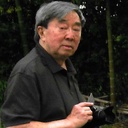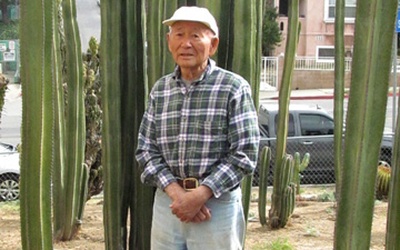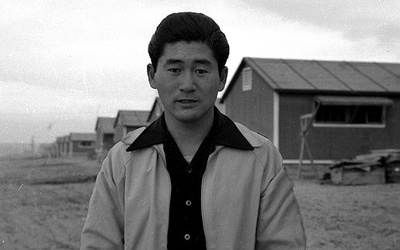
Gary T. Ono
@garyonoGary T. Ono, is a Sansei transplant from San Francisco, California who now resides in the Little Tokyo area of Los Angeles. He is a volunteer photographer for the nearby Japanese American National Museum. In 2001, he was awarded a California Civil Liberties Public Education Program grant to produce a video documentary, Calling Tokyo: Japanese American Radio Broadcasters of World War II. This story about what his father did during the war sparked his interest in his Japanese American and family history, which richly fills his senior moments.
Updated May 2013
Stories from This Author
Perspective and Thoughts on the 2018 Tule Lake Pilgrimage
Sept. 25, 2018 • Gary T. Ono
I have never attended a Tule Lake Pilgrimage, however, I was incarcerated at Amache, one of the other ten U.S. concentration camps of WWII. So, Amache was my primary focus of interest. As early as 1994, I attended an Amache Reunion in Las Vegas. Since 2008, I have volunteered with the Denver University Anthropology Department's Summer graduates study and Archaeological Field Survey of the Amache site, led by Dr. Bonnie Clark. She accepted volunteers inviting former internees and family members. …
Separation Anxiety: Former and Current Events Parallel
July 11, 2018 • Gary T. Ono
Tears moisten my eyes as I watch and listen to the 24/7 news coverage of the Zero Tolerance enforcement of President Trump's immigration policy. Frequently referred to as “compassionless,” Trump’s policy, ill-designed to deter asylum seeking immigrants from Central America, ‘punishes’ them by separating them from their children! The realization that some of these children might not ever see their parents again is emotionally draining and galling! Even if they are eventually reunited, the immediate negative emotional impact will handicap …
More “Made in Camp” Samurai Swords Discovered
Feb. 16, 2018 • Gary T. Ono
The Samurai Spirit In my 2015 Discover Nikkei essay, “Samurai Spirit in WWII Camps,” I put forth my belief that gaman—a Japanese term of Zen Buddhist origin that means “enduring the seemingly unbearable with patience and dignity”—surely must have burned especially bright in the hearts and minds of the Issei. Gaman was also characteristic of the temperament of the samurai, whose spirit I believe led to the making of swords in camp. My earlier essay discussed two handcrafted swords. Now, …
Samurai Spirit In WWII Camps
Aug. 20, 2015 • Gary T. Ono
As a volunteer at the Japanese American National Museum (JANM), recent developments there revealed that hidden Samurai spirits nestled in the minds and bodies of some of those imprisoned in the US concentration camps that held America’s Japanese prisoners for the duration of World War II. As you will shortly see, that speaks for Tokuichi Muro, a concentration camp inmate shown with his wife, Koito (Funai) Muro, interned in Amache, the War Relocation Authority Center (camp) near Granada, Colorado. I …
You Can Call Me Ben
Aug. 8, 2014 • Gary T. Ono
“What’s in a name? That which we call a rose by any other name would smell as sweet.” (Shakespeare; Romeo and Juliet) William pretty much sums it up for me as far as names go, but it is interesting to learn about how names are determined by different times and cultures. In Japan, middle names were not used, but in the turn-of-the-century America, Japanese pioneer immigrants, Issei, in most cases gave their Nisei children, second generation Japanese in America, Japanese …
Story Behind the Name – Amache
Feb. 4, 2014 • Gary T. Ono
It’s been mentioned before: the Granada War Relocation Authority Center in Colorado, one of ten such WWII American concentrations camps scattered throughout the U.S.A., was given a name change to Amache. The name change was to avoid the confusion of having two U.S. Post Offices within a mile-and-a-half of each other with the same name. One was the nearby town of Granada; the other was the Granada WRA camp. It was a practical decision, but it turned out to provide …
Jack Muro’s Garden
Jan. 10, 2014 • Gary T. Ono
I know, I know, I’ve written about Jack Muro before!—Jack as the “Underground Photographer of Amache,” “Jack Muro’s Photo Album,” and Jack being “Patriotic After All,” but Jack keeps inspiring me to write yet another essay for the JANM Discover Nikkei website. I was getting ready to leave his and his wife Kate’s home following a successful telephone conference call interview of Jack, conducted by Denver George Washington High School students: Maureen McNamara, Haelee Chin, and Alex Barone-Camp. These same …
Jack Muro: Still Patriotic After All
July 4, 2013 • Gary T. Ono
“Give me liberty or give me death!” was the climactic closing statement of a speech given by Patrick Henry, in 1775, as one of the leading founders in America’s fight for independence from England. Jack Muro, who was born December 3, 1921 and raised in Winters, California said that he and his friends loved America and all grew up very patriotic and believed in all the principles of democracy won in the hard fought battles for independence. They learned their …
Jack Muro, The Underground Photographer of Amache
May 13, 2013 • Gary T. Ono
A retired photographer, I volunteer at the Japanese American National Museum (JANM), in Little Tokyo, downtown Los Angeles. Having been and still involved in photography is why I was so impressed when I learned about Jack Yoshihide Muro. He was a photographer too. Jack was also like me, an inmate of Amache, a concentration camp, one of ten such War Relocation Authority camps scattered throughout the United States holding up to 120,000 of America’s Japanese as civilian prisoners for the …
Camp Pets: Doggone It! - Part 2
Aug. 28, 2012 • Gary T. Ono
Read Part 1 >> There are other pet stories that turned out happier. Before the war, Jack Muro and his parents were farmers in Winters, California. The dog of a neighboring sheepherder family had a litter of puppies. They offered the Muro family the pick of the litter. The Muros named their chosen pup, Poochie, who grew up as a much-loved family member. After Jack graduated from Winters High School, he moved to Los Angeles to work with an uncle in …














